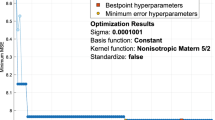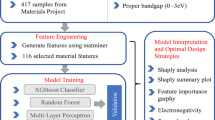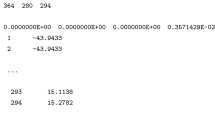Abstract
Using machine learning (ML) approach, we unearthed a new III–V semiconducting material having an optimal bandgap for high-efficient photovoltaics with the chemical composition of Gallium–Boron–Phosphide (\(\hbox {GaBP}_{2}\), space group: \(\hbox {Pna2}_{1}\)). ML predictions are further validated by state-of-the-art ab initio density functional theory simulations. The stoichiometric Heyd–Scuseria–Ernzerhof bandgap of \(\hbox {GaBP}_{2}\) is noted to be 1.65 eV, a close ideal value (1.4–1.5 eV) to reach the theoretical Queisser–Shockley limit. The calculated electron mobility is similar to that of silicon. Unlike perovskites, the newly discovered material is thermally, dynamically and mechanically stable. Above all the chemical composition of \(\hbox {GaBP}_{2}\) is non-toxic and relatively earth abundant, making it a new generation of PV material. Using ML, we showed that with a minimal set of features, the bandgap of III–III–V and II–IV–V semiconductor can be predicted up to an RMSE of less than 0.4 eV. We have presented a set of scaling laws, which can be used to estimate the bandgap of new III–III–V and II–IV–V semiconductor, with three different crystal phases, within an RMSE of \(\approx \) 0.4 eV.







Similar content being viewed by others
References
Shockley W, Queisser HJ (1961) Slip patterns on boron‐doped silicon surfaces. J Appl Phys 32:510–519
Miller OD, Yablonovitch E, Kurtz SR (2012) Strong internal and external luminescence as solar cells approach the shockley–queisser limit. IEEE J Photovolt 2:303–311
Grätzel M (2001) Photoelectrochemical cells. Nature 414:338–344
Priolo F, Gregorkiewicz T, Galli M, Krauss TF (2014) Silicon nanostructures for photonics and photovoltaics. Nat Nanotechnol 9:19–32
Green M A (2009) The path to 25% silicon solar cell efficiency: history of silicon cell evolution. Prog Photovolt 17:183–189
Curtarolo S, Hart GL, Nardelli MB, Mingo N, Sanvito S, Levy O (2013) The high-throughput highway to computational materials design. Nat Mater 12:191–201
Greenu M, Emery K, Hishikawa Y, Warta W, Dunlop E (2015) Solar cell efficiency tables (version 44). Prog Photovolt 23:805–812
Singh P, Ravindra NM (2012) Temperature dependence of solar cell performance—an analysis. Sol Energy Mater Sol 101:36–45
Wesoff E (2016) Green Tech Media (PV Modules)
Peters IM, Buonassisi T (2018) Energy yield limits for single-junction solar cells. Joule 2:1160–1170
Wang R, Mujahid M, Duan Y, Wang Z-K, Xue J, Yang Y (2019) A review of perovskites solar cell stability. Adv Funct Mater 29:1808843
Meng L, You J, Yang Y (2018) Addressing the stability issue of perovskite solar cells for commercial applications. Nat Commun 9:5265
Lahourcade L, Coronel NC, Delaney KT, Shukla SK, Spaldin NA, Atwater HA (2013) Structural and optoelectronic characterization of RF sputtered ZnSnN2. Adv Mater 25:2562–2566
Senabulya N, Feldberg N, Makin RA, Yang Y, Shi G, Jones CM, Kioupakis E, Mathis J, Clarke R, Durbin SM (2016) Stabilization of orthorhombic phase in single-crystal ZnSnN2 films. AIP Adv 6:075019
Feldberg N, Aldous J, Linhart W, Phillips L, Durose K, Stampe P, Kennedy R, Scanlon D, Vardar G, Field R III et al (2013) Growth of ZnSnN2 by molecular beam epitaxy. Appl Phys Lett 103:042109
Skachkov D, Quayle PC, Kash K, Lambrecht WR (2016) Disorder effects on the band structure of ZnGeN2: role of exchange defects. Phys Rev B 94:205201
Zakutayev A, Allen AJ, Zhang X, Vidal J, Cui Z, Lany S, Yang M, DiSalvo FJ, Ginley DS (2014) Experimental synthesis and properties of metastable CuNbN2 and theoretical extension to other ternary copper nitrides. Chem Mater 26:4970–4977
Wang C, Chen S, Yang J-H, Lang L, Xiang H-J, Gong X-G, Walsh A, Wei S-H (2014) Design of I2–II–IV–VI4 semiconductors through element substitution: the thermodynamic stability limit and chemical trend. Chem Mater 26:3411–3417
Fioretti AN, Zakutayev A, Moutinho H, Melamed C, Perkins JD, Norman AG, Al-Jassim M, Toberer ES, Tamboli AC (2015) Combinatorial insights into doping control and transport properties of zinc tin nitride. J Mater Chem C 3:11017–11028
Martinez AD, Warren EL, Gorai P, Borup KA, Kuciauskas D, Dippo PC, Ortiz BR, Macaluso RT, Nguyen SD, Greenaway AL et al (2016) Solar energy conversion properties and defect physics of ZnSiP2. Energy Environ Sci 9:1031–1041
Narang P, Chen S, Coronel NC, Gul S, Yano J, Wang L-W, Lewis NS, Atwater HA (2014) Bandgap tunability in Zn(Sn,Ge)N2 semiconductor alloys. Adv Mater 26:1235–1241
Pandey M, Kuhar K, Jacobsen KW (2017) II–IV–V2 and III–III–V2 polytypes as light absorbers for single junction and tandem photovoltaic devices. J Phys Chem C 121:17780–17786
Tang F, Zhu T, Oehler F, Fu WY, Griffiths JT, Massabuau FC-P, Kappers MJ, Martin TL, Bagot PA, Moody MP et al (2015) Indium clustering in a-plane InGaN quantum wells as evidenced by atom probe tomography. Appl Phys Lett 106:072104
Lee JK, Park B, Song K, Jung WY, Tyutyunnikov D, Yang T, Koch CT, Park CG, van Aken PA, Kim Y-M et al (2018) Strain-induced indium clustering in non-polar a-plane InGaN quantum wells. Acta Mater 145:109–122
Reyes DF, Gonzalez D, Bastiman F, Dominguez L, Hunter CJ, Guerrero E, Roldan MA, Mayoral A, David JP, Sales DL (2013) Photoluminescence enhancement of InAs (Bi) quantum dots by Bi clustering. Appl Phys Express 6:042103
Martini S, Quivy A, Lamas T, Da Silva M, Da Silva E, Leite J (2003) Influence of indium segregation on the RHEED oscillations during the growth of InGaAs layers on a GaAs (0 0 1) surface. J Cryst Growth 251:101–105
Barlow AJ, Sano N, Murdoch BJ, Portoles JF, Pigram PJ, Cumpson PJ (2018) Observing the evolution of regular nanostructured indium phosphide after gas cluster ion beam etching. Appl Surf Sci 459:678–685
Mannarino M, Chintala R, Moussa A, Merckling C, Eyben P, Paredis K, Vandervorst W (2015) Surface characterization of InP trenches embedded in oxide using scanning probe microscopy. J Appl Phys 118:225304
Scanlon D O, Walsh A (2012) Bandgap engineering of ZnSnP2 for high-efficiency solar cells. Appl Phys Lett 100:251911
Gautam R, Singh P, Sharma S, Kumari S, Verma A (2015) Structural, electronic, optical, elastic and thermal properties of CdGeP2 with the application in solar cell devices. Mater Sci Semicond Process 40:727–736
Butler KT, Davies DW, Cartwright H, Isayev O, Walsh A (2018) Machine learning for molecular and materials science. Nature 559:547–555
Sparks TD, Gaultois MW, Oliynyk A, Brgoch J, Meredig B (2016) Data mining our way to the next generation of thermoelectrics. Scr Mater 111:10–15
Xue D, Xue D, Yuan R, Zhou Y, Balachandran PV, Ding X, Sun J, Lookman T (2017) An informatics approach to transformation temperatures of NiTi-based shape memory alloys. Acta Mater 125:532–541
De Jong M, Chen W, Notestine R, Persson K, Ceder G, Jain A, Asta M, Gamst A (2016) A statistical learning framework for materials science: application to elastic moduli of k-nary inorganic polycrystalline compounds. Sci Rep 6:34256
Zheng X, Zheng P, Zhang R-Z (2018) Machine learning material properties from the periodic table using convolutional neural networks. Chem Sci 9:8426–8432
Pilania G, Wang C, Jiang X, Rajasekaran S, Ramprasad R (2013) Accelerating materials property predictions using machine learning. Sci Rep 3:2810
Goodman C (1957) A new group of compounds with diamond type (chalcopyrite) structure. Nature 179:828–829
Jaffe J, Zunger A (1984) Theory of the band-gap anomaly in ABC2 chalcopyrite semiconductors. Phys Rev B 29:1882–1906
Pedregosa F et al (2011) Scikit-learn: machine learning in Python. J Mach Learn Res 12: 2825-2830.
Chen T, Guestrin C (2016) In: Proceedings of the 22nd ACM sigkdd international conference on knowledge discovery and data mining. ACM, pp 785–794
Kresse G, Furthmüller J (1996) Efficiency of ab-initio total energy calculations for metals and semiconductors using a plane-wave basis set. Comput Mater Sci 6:15–50
Kresse G, Furthmüller J (1996) Efficient iterative schemes for ab initio total-energy calculations using a plane-wave basis set. Phys Rev B 54:11169–11186
Kresse G, Joubert D (1999) From ultrasoft pseudopotentials to the projector augmented-wave method. Phys Rev B 59:1758–1775
Perdew JP, Burke K, Ernzerhof M (1996) Perdew, burke, and ernzerhof reply. Phys. Rev. Lett. 77:3865–3868
Monkhorst H J, Pack J D (1976) Special points for Brillouin-zone integrations. Phys Rev B 13:5188–5192
Becke AD, Johnson E R (2006) A simple effective potential for exchange. J Chem Phys 124:221101
Heyd J, Peralta JE, Scuseria GE, Martin RL (2005) Energy band gaps and lattice parameters evaluated with the Heyd-Scuseria-Ernzerhof screened hybrid functional. J Chem Phys 123:174101
Mandia AK, Muralidharan B, Choi J-H, Lee S-C, Bhattacharjee S (2019) arXiv preprint arXiv:1907.08005
Huang Y, Yu C, Chen W, Liu Y, Li C, Niu C, Wang F, Jia Y (2019) Band gap and band alignment prediction of nitride-based semiconductors using machine learning. J Mater Chem C 7:3238–3245
Rajan AC, Mishra A, Satsangi S, Vaish R, Mizuseki H, Lee K-R, Singh AK (2018) Machine-learning-assisted accurate band gap predictions of functionalized MXene. Chem Mater 30:4031–4038
Olsthoorn B, Geilhufe RM, Borysov SS, Balatsky AV (2019) Band gap prediction for large organic crystal structures with machine learning. Adv. Quantum Technol 2:1900023
Sotskov V et al (2018) Band gap prediction for inorganic crystals with machine learning. Master thesis
Dalven R (1973) Empirical relation between energy gap and lattice constant in cubic semiconductors. Phys Rev B 8:6033–6034
Morales-Garcia A, Valero R, Illas F (2017) An empirical, yet practical way to predict the band gap in solids by using density functional band structure calculations. J Phys Chem C 121:18862–18866
Chan M, Ceder G (2010) Efficient band gap prediction for solids. Phys Rev Lett 105:196403
Garza A J, Scuseria G E (2016) Predicting band gaps with hybrid density functionals. J Phys Chem Lett 7:4165–4170
Nguimdo G D, Joubert D P (2015) A density functional (PBE, PBEsol, HSE06) study of the structural, electronic and optical properties of the ternary compounds AgAlX2 (X = S, Se, Te). Eur Phys J B 88:113
Togo A, Tanaka I (2015) First principles phonon calculations in materials science. Scr Mater 108:1–5
Mouhat F, Coudert F-X (2014) Necessary and sufficient elastic stability conditions in various crystal systems. Phys Rev B 90:224104
Rode D (1975) Low-field electron transport. In: Semiconductors and semimetals, vol 10. Elsevier, Amsterdam, pp 1–89
Mandia AK, Patnaik R, Muralidharan B, Lee S-C, Bhattacharjee S (2019) Ab initio semi-classical electronic transport in ZnSe: the role of inelastic scattering mechanisms. J Phys Condens Matter 31:345901
Faghaninia A, Ager JW III, Lo CS (2015) Ab initio electronic transport model with explicit solution to the linearized Boltzmann transport equation. Phys Rev B 91:235123
Gunning BP, Moseley MW, Koleske DD, Allerman AA, Lee SR (2017) Phase degradation in BxGa1−xN films grown at low temperature by metalorganic vapor phase epitaxy. J Cryst Growth 464:190–196
Williams L, Kioupakis E (2017) BInGaN alloys nearly lattice-matched to GaN for high-power high-efficiency visible LEDs. Appl Phys Lett 111:211107
Atsumi K, Inoue Y, Mimura H, Aoki T, Nakano T (2014) Neutron detection using boron gallium nitride semiconductor material. APL Mater 2:032106
Orsal G, Maloufi N, Gautier S, Alnot M, Sirenko AA, Bouchaour M, Ougazzaden A (2008) Effect of boron incorporation on growth behavior of BGaN/GaN by MOVPE. J Cryst Growth 310:5058–5062
Ougazzaden A, Gautier S, Moudakir T, Djebbour Z, Lochner Z, Choi S, Kim HJ, Ryou J-H, Dupuis RD, Sirenko AA (2008) Bandgap bowing in BGaN thin films. Appl Phys Lett 93:083118
Acknowledgements
Upendra Kumar is profoundly thankful to Mr. Dhaval Patel the founder of CodeBasics-Lets code! (https://codebasicshub.com/) website for giving motivation and valuable suggestion in machine learning.
Author information
Authors and Affiliations
Contributions
UK and SN conceived the idea and contribute equally in the the machine learning and DFT part of the calculation. SC carried out the transport calculations. SN and UK wrote the manuscript. All authors read the manuscript. SB and S-C. L supervised the project.
Corresponding author
Additional information
Publisher's Note
Springer Nature remains neutral with regard to jurisdictional claims in published maps and institutional affiliations.
Electronic supplementary material
Below is the link to the electronic supplementary material.
Rights and permissions
About this article
Cite this article
Kumar, U., Nayak, S., Chakrabarty, S. et al. Gallium–Boron–Phosphide (\(\hbox {GaBP}_{2}\)): a new III–V semiconductor for photovoltaics. J Mater Sci 55, 9448–9460 (2020). https://doi.org/10.1007/s10853-020-04631-5
Received:
Accepted:
Published:
Issue Date:
DOI: https://doi.org/10.1007/s10853-020-04631-5




